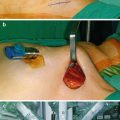Fig. 36.1
Calciphylaxis in the lower limb
Better medical control and the introduction of calcimimetics have significantly reduced the need for parathyroidectomy, but it is estimated that up to 10 % of patients may require surgery after 10–15 years of renal replacement therapy. The efficacy of parathyroidectomy in calciphylaxis is uncertain, but may have a role in patients with severe hypercalcemia that do not respond to calcimimetics.
Following successful renal transplantation, most patients become normocalcemic, but it may take several months, and fewer than 5 % of patients will require parathyroidectomy to treat hypercalcemia.
Surgical Options
There is no consensus regarding the optimal surgical procedure for these patients. The literature is hampered by few publications with small numbers of patients, a dearth of randomized studies, and huge variability in the way that the results are presented. There are three available procedures:
Subtotal parathyroidectomy (sPTX) – excising 3.5 parathyroid glands.
Total parathyroidectomy with autotransplantation (tPTX + AT) – all four parathyroid glands are excised and a small remnant of minced parathyroid tissue is autotransplanted into the forearm or neck muscle.
Total parathyroidectomy alone (tPTX) (without autotransplantation) – all four parathyroid glands are excised.
There is no evidence to suggest that any one approach is superior. Recurrence rates for sPTX and tPTX + AT are similar. The latter has the theoretical advantage that redo surgery in the neck could be avoided if the autograft is sited in the forearm. The lowest recurrence rates are seen in tPTX. Even when all parathyroid glands are removed, PTH levels remain detectable, and the theoretical concerns about a dynamic bone disease appear unfounded.
Other factors that influence the operative approach include:
The likelihood that the patient will receive a kidney transplant
Patient age and expected survival
Surgeon’s preference
Up to one-third of patients with renal HPT will have supernumerary glands, of which most are in the thymus. Routine thymectomy has been shown to reduce the rate of recurrent HPT.
Surgical Tips
Preoperative
Close liaison with nephrologists.
Stay updated, free articles. Join our Telegram channel

Full access? Get Clinical Tree





